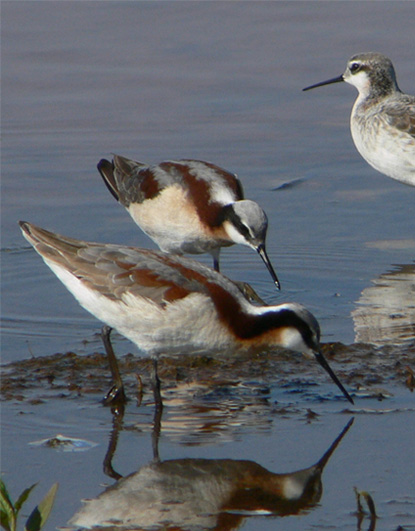
By John Shackford
The Wilson’s Phalarope (Phalaropus tricolor) is named after the early American ornithologist Alexander Wilson (1766-1813). There are three species of phalaropes: in additional to Wilson’s, are the Red-necked and the Red phalaropes. The Wilson’s Phalarope nests only in North America, while the other two species nest circumpolar. The Wilson’s Phalarope usually chooses freshwater lakes and ponds, both on its nesting and wintering grounds, rather than seacoasts. Its winter range is not well understood, but it is in the southwestern part of South America.
In Oklahoma the Wilson’s Phalarope is found primarily as a migrant—Sutton (1967. Oklahoma Birds) gives migratory dates as from March 23-June 6 and from July 1-September 24, being more common in spring than fall. Population-wise they are found most commonly in the Oklahoma Panhandle (where it is sometimes seen by the dozens or even hundreds), and tapering off eastward to central Oklahoma, with additional sporadic reports even further east. In central Oklahoma they have been seen most frequently at Rose Lake, John Newell having turned in most of the records [1982, Sutton, summaries of Oklahoma bird species, Wilson’s phalarope, unpublished data].
In reading Bent (Life histories of North American shore birds. 1927, part 1. Dover Publ., Inc. N.Y., NY), I was surprised that the Wilson’s Phalarope had been found nesting (rarely) in Meade County, southwestern Kansas, adjacent to Beaver County in the Oklahoma Panhandle. Another record also raised my interest in possible nesting in Oklahoma: on August 21, 1970 Sutton and Best [1982, Sutton cited above] reported four “young” at the Boise City sewage ponds; these were no doubt flighted birds, because Sutton certainly would have made more of the record if they had been too young to fly.
All of this led me to try to find out exactly where the nesting range of the species is, and I was totally surprised when a page from the Breeding Bird Atlas of Texas (R. C. Tweit, (2009), Wilson’s Phalarope, The Texas Breeding Bird Atlas. Texas A&M University System, College Station and Corpus Christi, TX) jumped onto my computer screen showing three confirmed nest records in the Texas Panhandle. These records were in the southern one-half of the Texas Panhandle, well south of the Oklahoma Panhandle. That atlas also listed the Breeding Bird Atlas of Oklahoma as a reference (2004. B. L. Gall, Wilson’s Phalarope, In Oklahoma breeding bird atlas, pp. 156-157, D. L. Reinking, ed., University of Oklahoma Press, Norman). I went to this work and found a write-up by Gall which gave three probable nesting sites, one in each of the Oklahoma Panhandle counties, and one confirmed record for northeastern Cimarron County; there was, however, some ambiguity about this confirmed record and Gall commented that nesting in Oklahoma needed further research. I was totally amazed at this record. For many years I had worked on breeding bird species in Cimarron County and had never even considered the possibility of Wilson’s Phalaropes nesting there! With the Texas and Oklahoma records mentioned above, I think we should be watching Hackberry Flats (a restored wildlife area in the southwestern part of Oklahoma), the Great Salt Plains Refuge, and of course the Oklahoma Panhandle, particularly Cimarron County, for nesting Wilson’s Phalaropes.
The Wilson’s Phalarope has an unusual mating pattern: they are polyandrous, whereby the female selects more than one male partner during a season. And very interestingly, the female is the brightly-colored sex of the species and she performs the normal courtship functions, rather than the males, as in most other bird species: she leaves a male with nest building (usually rudimentary), incubation of eggs, and care of the young. Thus, the female only lays eggs (usually four), then quickly moves on to pursue nesting with a second male, the female again leaving all nesting duty to a second male. The advantage of this mating system is that the female can produce two broods in about the same amount of time it normally takes to complete only about one-and-a-half nests in most other species. This is a very significant change because the length of the breeding season in the far north is so short that nesting time is at a premium, and “half a nesting” in the far north actually means no second nesting at all.
Although the Wilson’s Phalarope feeds primarily on shore or while wading in the water, they have an interesting behavior while floating on water: they spin in small, tight circles, stirring up small food that they can pick up to eat (this behavior is very useful in identifying phalaropes in general). Bent (cited earlier) gives one study of this phalarope’s food that found 43.1% was animal and 24.4% was vegetable.
